Clocks, 1940s - 1960s UK

Before the digital era, clock mechanisms contained moving parts which had to be kept moving at a constant rate in order to keep good time. This page describes with illustrations how wind-up clocks, pendulum clocks and weighted cuckoo clocks worked. First, though, a little about where to see them, because they were not cheap to buy.
____
By the webmaster based on childhood and young adult observation and further research
Although my recollections of clocks start from the early 1940s, I understood from older people that nothing much had changed from the earlier years of the 20th century and even before.
Where to see clocks
From today's perspective, you might be surprised that where to see clocks would be worthy of a section in its own right. The reason is that clocks were expensive, even though less so than wrist watches and pocket watches because their parts, being larger, were easier to make. So my family household in the 1940s, which was probably fairly typical, had one clock in the kitchen, one in the hall, one in the sitting room and one in my parents' bedroom. There was no means of telling the time in the other rooms. This was significant because so few people had watches - but what we never knew, we never missed.
Apart from in the home, there were clocks in most major public places, for example in station booking offices, on church towers and inside larger shops. These clocks had big faces, so that they could be read at a distance.
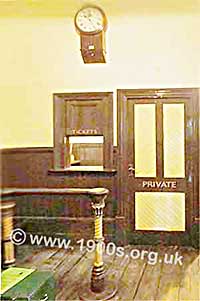
Clock in the booking office of a small station
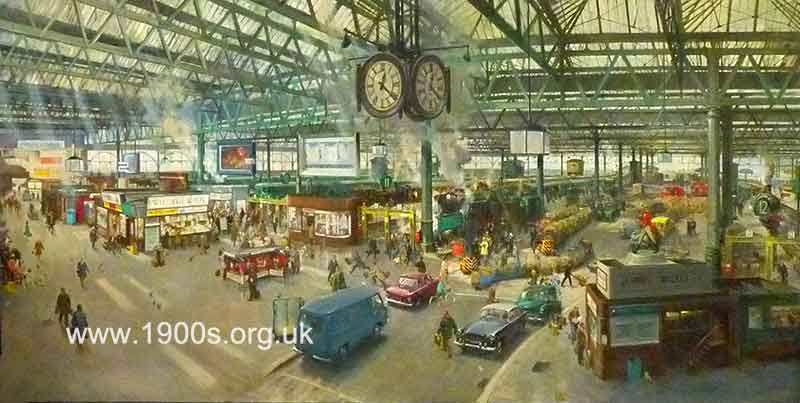
Clock in a large London station, detail from a poster in York Railway Museum
Most owners of public clocks took pride in maintaining their clocks so that they kept reasonably good time. This involved regular minor adjustments to the mechanisms, as outlined below.
How wind-up clocks worked and were set
The most common types of domestic clock were driven by a spring which kept the clock going as the spring unwound. Before the spring was completely unwound it had to be wound up again to tighten the spring. Otherwise the clock stopped.
Keys to wind clocks
Clocks were wound with keys. These keys were unique for each clock. The keyhold was normally in the front clock face.

Example of key for winding up a clock. They came in various shapes and sizes, but always seemed to be hollow to take the winding rod.
It was important not to lose the key which was often tucked away behind or on top of the clock.
The sliding lever to make the clock go faster or slower
Also on the clockface of wall clocks was a small sliding lever which could be moved one way or the other to make the clock run faster if it was found to be losing time or more slowly if it was found to be gaining. The adjustment, though, was trial and error. Ideally the clock would eventually run at the right speed, but this seldom happened totally satisfactorily. Even changes in temperature affected mechanisms.
Some clocks had to be wound up every day, which was easy to forget, with the result that the clock stopped. Most, though, lasted 8 days, although some lasted longer, and it was usually the task of the man of the house to go round and wind them up. This was a weekly event. In our house it was on a Friday evening - which incidentally was also 'bath night'.
Setting the time was merely a matter of moving the hands into position, normally with one's fingers - but for chiming clocks this always had to be done in a forward direction to protect the mechanism. So even if the clock was just a few minutes fast, its hands had to be moved nearly all the way round its 12-hour face. No clock in ordinary households had a 24-hour face.
Mantel clocks
Clocks for shelves, mantelpieces and bedside tables were known as mantel clocks. Being portable, there was easy access to their backs which was where the controls were. This is shown well in the following images. Note that the winding key is not aa normal key in that it is fixed and rests fla.
Most wind-up clocks in the 1940s were in metal or wooden cases with a glass panel in a door at the front.
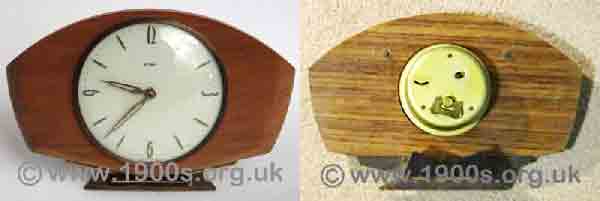
Front and back of a typical wind-uo bedside or mantelepiece clock in the 1930s to 1950s. The controls are at the back and fixed; The winder wound the clock in the normal way and was pulled out slightly to set the hands. The sliding lever to make the clock go faster or more slowly is above the key and to its left.
Some mantel clocks did have separate keys; the glass hinged open to get to the keyhole in the front face.
Pendulum clocks
Pendulum clocks were pieces of furniture and were necessarily tall and narrow to house the pendulum. They were in polished dark wood cabinets with tall doors at the front to get to the pendulum and the other controls which were normally set in the front face. This door usually contained a glass window because seeing the pendulum swing from side to side showed that the clock was working and was considered attractive. It was also quite mesmerising.

Grandfather clock, photographed in Milestones Museum
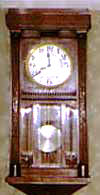
Wall mounted pendulum clock in my parents' home, bought early 1940s
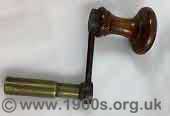
Grandfather clock winding handle
Grandfather, grandmother and granddaughter clocks
My husband's parents had a floor-standing pendulum clock that had been in his family for generations and which was known affectionately as Grandpa, because these types of clocks were called grandfather clocks. My own parents had a smaller pendulum clock which was wall mounted.
Grandfather clocks used a slowly falling weight to drive them. They needed to be wound up with a winding handle which required many turns. While turning the handle there was a continuous clicking noise and the weights could be seen moving up.
The pendulum clock in my family made a clonking sound which in some strange way we regarded as company.
Pendulum clocks could be made to go faster or more slowly by adjusting the position of the pendulum bob up or down.
All the pendulum clocks that I knew chimed the hour, and some chimed the quarter and half hours, although the chime could be turned off.
Small versions of grandfather clocks were known as grandmother and granddaughter clocks.
Cuckoo clocks
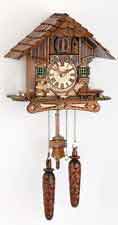
Cuckoo clock
I first came across cuckoo clocks when I visited Austria as a teenager in the 1950s, but such clocks must have been in existence long before that. They were driven by weights on a chain which passed over a pulley inside the clock and was left dangling below.
The cuckoo clock was 'wound up' by pulling the free end of the chain, so raising the weight. As with all pendulum clocks the bob could be adjusted up or down to make the clock go faster or more slowly.
Cuckoo clocks were beautifully carved and painted, and owed their name to the carved 'cuckoo' which popped out and sounded 'cuckoo', usually on the hour.
I have no experience of these clocks, so have no idea how accurate they were.
Travel clocks
Travel clock were wind-up clocks in a hard leather case. As the photos show, the clocks were hinged into their cases, which were also hinged, so that they could lie flat when the cases were closed for travelling. With the hinges open, they could be set to stand fairly upright for easy viewing on a bedside table.
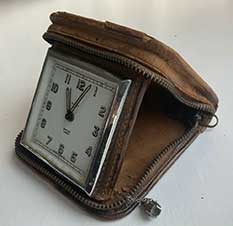
Zip to close leather travelling alarm clock, 1950s
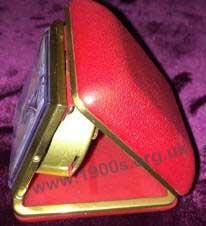
Snap to close leather travelling alarm clock, 1960s
Travel clocks were very popular indeed in the 1950s and 60s and their cases were regarded as fashion accessories. Mine, shown in the photo, was bright red but there was no shortage of other colours.
Analogue versus digital and early electric clocks
All the above clocks were analogue. This means that they had circular faces with numbers one to twelve around the outside, a hand to measure hours and a longer hand to measure minutes. Early electric clocks were digital which means that the display was rectangular, showing only numbers, rather like some of today's watches.
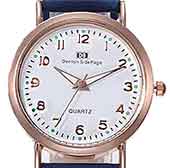
analogue face
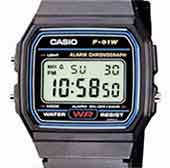
digital face
As the century progressed, electric clocks entered households with their digital displays. They were accurate which was in their favour, but most people preferred the analogue appearance because the position of the hands gave an instant indication of the passage of time. Fortunately there were developments which allowed electric clocks to have analogue displays.
In the 1960s my husband wanted to buy an electric clock which would work off the mains. However, I was averse to trailing leads, so we bought one of the new battery-operated ones instead.
Battery-operated clocks became very popular and were made in all sorts of designs. Today battery-operated clocks and watches are the norm.
| sources | webmaster | contact |
Text and images are copyright
If you can add anything to this page or provide a photo, please contact me.



